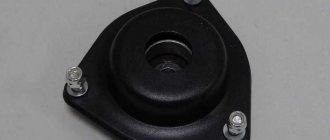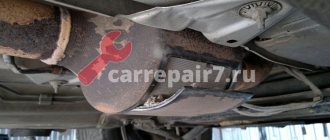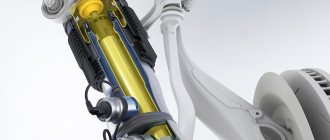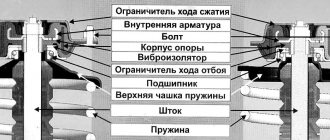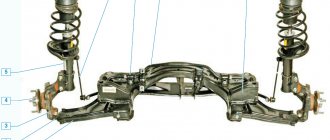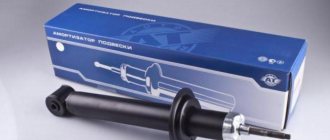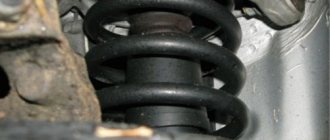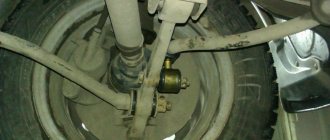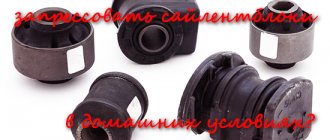A faulty shock absorber strut can be determined without removal: indirect signs and visual inspection are sufficient. It is important to carry out replacement and repairs in a timely manner. Since the safety of the driver, passengers and other road users depends on the proper operation of the part.
There are as many as 4 different methods for checking the strut without removing it:
- careful inspection; for this purpose it is advisable to remove the wheel;
- monitoring work under load;
- monitoring the car in motion on turns, when driving over uneven surfaces;
- measurement.
Visual inspection
The first thing you need to pay attention to is the appearance of the rack itself. Sometimes it will tell you much more about its condition than other testing methods. If the stand is leaking or is wet, it is advisable to replace it. To be sure of the diagnosis, you can simply wipe the surface of the shock absorber with a dry cloth. Then repeat the inspection a few days later.
It is advisable to lift the car on a lift: the shock absorber rods should shine. If there are traces of rust or other defects, this indicates that the part is not working properly. Another indirect sign is the presence of defects on the car tires. The presence of uneven wear indicates an asymmetrical load. Among other things, it is important to assess the condition:
- protective kit - boots, springs;
- upper supports.
Diagnostics
During normal vehicle use, shock absorber struts usually last 3-4 years, often even longer. But this period can be significantly reduced if you decide to save money and purchase a cheap low-quality part. The service life of the racks also depends on the correct installation, driving style and road conditions.
There is no point in trying to manually rock the car to determine the health of the shock absorbers. The actual amplitude of the vehicle's sway while in motion is much higher, so this method can only identify completely damaged shock absorbers.
The behavior of the car in motion will tell much more about the condition of the struts. The following signs may indicate problems:
- knocking or creaking while driving;
- significant shaking and long attenuation of vibrations of the machine body;
- deterioration of road grip, especially noticeable when entering a turn at speed;
- increase in braking distance in the absence of problems with the brakes;
- when accelerating, the rear of the car noticeably squats, and when braking, it nods;
- obvious traces of hydraulic fluid leakage due to a worn shock absorber seal;
- uneven tire wear;
- shock absorber cylinder deformation, spring corrosion or other obvious damage to strut elements.
More accurate diagnostics can be made at a service station that has a special stand. The car is rocked on it, and sensors record the amplitude of the vibrations. As a result, the system determines the remaining service life of the racks as a percentage, and service specialists give an opinion on the possibility of their further operation.
Load on the car body
The old, old-fashioned method is to rock the car body and see how the racks work out this movement. If after one shock the shock absorber has made more than 1 translational movement, then it is time to change it. But you need to remember: this method will only be relevant if the shock absorber is completely “dead”. It will also allow you to identify a jammed shock absorber. It will be simply impossible to rock the body.
Management, operation
Indirect signs of faulty shock absorber struts - problems when operating the machine:
- the wheels “yaw” when driving over uneven surfaces;
- there is a swing in different directions - for no apparent reason;
- lack of normal feedback on the steering wheel.
It must be remembered: such signs of faulty struts are present not only at high speeds. But even if the speedometer is much less than 60 km/h. It is important to remember that deterioration in controllability is one of the first signs of a malfunction not only in the steering system. But also shock absorbers.
Measuring distances and sizes
One of the simplest and most accurate ways to determine the presence of a malfunction is to measure the gaps and dimensions. The optimal solution: take it to a service station. Qualified technicians will definitely help determine whether replacement is necessary. It must be remembered that even one faulty shock absorber affects the efficiency of the vehicle’s suspension system.
It must be remembered that working with a stand in a workshop implies the need to configure it for a specific car. For example, it often happens that the data indicated almost complete wear of the car’s suspension. At the same time, on the road, regardless of speed, the car behaved perfectly. The reason was simple: the stand was simply not configured to work with a rigid suspension.
Try it on!
The simplest, fairly quick and not so expensive way to get general information about the effectiveness of the suspension is to stop by a diagnostic stand, take measurements and listen to the verdict.
Another question is how precisely the verdict will apply directly to shock absorbers. The fact is that in the case of various kinds of “shaking” (of which there are more and more recently), the presence of at least one faulty element (not necessarily a shock absorber) will significantly affect the final results of the efficiency indicator. In addition, the algorithms by which the performance of the suspension are assessed differ, and diagnostics of one car on different stands can lead to the fact that the data obtained on the condition of the suspension may differ.
Suspension knocks and creaks. How to fix
Extraneous sounds often occur in the suspension and shock absorbers. These are knocks and creaks. Most often this is present in the front part of the suspension. Moreover, the reason does not necessarily lie in the rack itself. Sounds can be made by:
- Tie Rod;
- support bearing;
- spherical bearing.
Problems in these units arise more often than in shock absorber struts. Therefore, if extraneous sounds occur, you must first check them. Usually the problem lies in the bearing. Replacing it is not a problem even if you have no experience. A minimal set of tools is enough. The situation is similar with the ball joint.
But sometimes the problem lies precisely in the shock absorber strut. One of the common problems is that the bump stop makes strange sounds. It just falls down the stem. Which leads to squeaking.
The problem may lie in the strut washer: when it does not press the bushing of the support itself well against the bearing. It is necessary to immediately change the washers and supports at the same time. Creaking often occurs in certain situations. For example, on bumps. In this case, the reason in almost 1000% of cases lies in the shock absorber struts. There is only one way to fix this - complete replacement.
Shock absorbers in a car should be checked regularly
According to experts, in our country, due to the old age of the vehicle fleet, as well as due to the poor well-being of the population, a huge number of cars on our roads are operated with worn out or broken shock absorbers (dampers). A particularly sharp increase in the poor technical condition of vehicles has been observed since the simplification of the technical inspection procedure. By the way, not many experienced car enthusiasts know that it is advisable to check the condition of the shock absorbers if the car’s mileage has exceeded 80,000 km. Further, shock absorbers should be checked every 20,000 km. And not just anywhere, but strictly at a special stand. As you already understand, this can only be done in a specialized technical auto center.
What to do if the shock absorber strut leaks: consequences
Shock absorbers leak due to their design: they are a cylinder that runs in a special sleeve. A special piston moves through a mass of oil or gas (or both at the same time - a combined type). The rod is fixed on it. Thanks to which there is no compression or stretching. The oscillation process itself takes place thanks to the jets.
They are small in size. It is for this reason that the rod moves a short distance, slowly. To prevent oil leakage, the gas outlet from the shock absorber in its upper part is equipped with special seals and gaskets. Thanks to them, the filling of the sleeve does not go beyond its limits. However, with severe wear, oil begins to gradually ooze out. This is due to the following details:
- stock;
- gaskets
The presence of leaking oil indicates that the part is gradually failing or has already failed! A leak indicates that the shock absorber has already exhausted its service life. It needs repair or replacement. A leak is an obvious sign of a suspension problem. Many people ask the question: is it possible to operate a car in this condition? There is no clear answer to this.
For example, if only one rack is out of order, then it is possible to use the car for a short time. But if the struts fail in pairs (two in front or behind), then it is better to stop driving until they are replaced. Because otherwise the car will “toss” along the road like on a roller coaster. Moreover, regardless of the speed of movement. Sudden maneuvers can lead to an accident. Moreover, replacement is best done immediately when the above symptoms occur.
Basic recommendations:
- if one pillar is leaking, then it is possible to use the car for a while without heavily loading the body;
- If 2 or 3 struts are leaking, you need to drive extremely carefully, at low speed and only to the nearest car service center!
When choosing shock absorbers you need to be careful. One of the compromise solutions in terms of price-quality ratio today is KAYABA.
What consequences await the driver when using the current struts?
Many people wonder: is it possible to drive and what are the possible consequences? When operating a vehicle with 2-4 failed shock absorbers, the following consequences will occur:
- the rest of the suspension parts will gradually fail, the body may “behave” - since the buffer in the form of a piston that absorbs shocks and vibrations will be absent;
- the suspension will take the blows and all sorts of rubber components (silent blocks, bushings and balls) will gradually fail - as they will absorb vibrations;
- the distance from the bottom of the car to the ground will be less - which can lead to damage on large bumps (for example, the muffler will simply tear off).
In addition to all other troubles, a decrease in controllability will also be added - it will drop significantly. If a leak has just appeared in the rack, but the oil has not yet had time to leak out, then it will work normally for some time. In terms of time, about 1-2 weeks, no more. If you use a car for a long time with faulty shock absorbers, this can lead to uneven wear of the rubber. Since there will be a skew of the body.
It is not recommended to drive at high speed even with one shock absorber not working. Controllability is significantly reduced, and there is a high probability of getting into a traffic accident. Moreover, the insurance company can easily refuse payment citing a car malfunction. Therefore, it is important to be careful when using a car with suspension problems. And this applies not only to shock absorber struts.
When the first signs of malfunction occur, it is necessary to replace it with a new one. It is advisable to purchase the original. Their resource is an order of magnitude greater, as is their quality.
Deputies signed the OSAGO verdict “in kind”
Now let’s assume that we are dealing with a careful driver who carefully looks after his “swallow”, but does it sparingly, especially in times of crisis.
Such a person has a great desire to purchase not original, but proven spare parts, because the difference in price between the first and second ones can be colossal. Especially when it comes to products from China. There is no doubt that auto component manufacturers from the Middle Kingdom have recently significantly improved the quality of their products. But let's compare all the costs that a car owner will incur by abandoning a high-quality, but expensive product in favor of a less reliable, but cheap one.
The elusiveness of the benefits from switching to “Chinese” can be illustrated by the example of some well-known “shock absorber” brand offering its far from cheap products on our market. Let it be the Japanese KYB (Kayaba) with its most common shock absorber in the world - the Excel-G series. In Russian retail, one Excel-G costs about 2,500 rubles. Now in Moscow, prices for replacing one shock absorber start at 1,000 rubles. Thus, replacing a pair of premium brand shock absorbers will cost at least 7,000 rubles. However, in order to save money, we will find a Chinese shock absorber costing 1000 rubles apiece - that is, not entirely dubious. Installing a couple of these “Chinese” ones will cost 4,000. The savings will thus be 3,000 rubles.
At the same time, reviews from real owners of Chinese shock absorbers indicate that their “life” on Russian roads is on average a year and a half, no more. Statistics say that the average annual mileage of an “average” passenger car during the crisis in Russia decreased by about a third - to 18,000 kilometers. Based on this, we can estimate the service life of a typical Chinese shock absorber - about 25,000 mileage. After this mark, you have to change it: purchase a new pair of these suspension dampers, go to a service station for replacement, and again spend money on adjusting the wheel alignment.
